10 Document Management Trends Boosting Productivity in SaaS Firms in 2025

Is document work a big distraction?
From SLAs to staff contracts, you need to organize and secure files for your SaaS.
However, with document work standing in the way, it becomes challenging to deliver high-quality software and user experiences faster than your competitors.
A Coveo study discovered that IT workers waste 50% of their time on document work. It’s no wonder SaaS businesses are struggling to grow.
So it’s important to stay in touch with the latest document management trends, because this will help your SaaS firm to organize, access and utilize information better. This in turn improves productivity, helping to streamline processes like software onboarding.
Incorporating these innovations will also accelerate document work, freeing up time to focus on improving your SaaS solution and expanding your product line.
In this article, we’ll discuss document management trends boosting productivity in SaaS firms in 2024 to help amplify efficiency and SaaS revenue sustainably.
Let’s get started.
1. AI-powered document classification
AI is revolutionizing document management in SaaS.
It leverages the power of machine learning, computer vision and natural language processing to understand the text or structure of a file in order to group it in the right category depending on in-file content, document name and other metadata.
With manual document classification strategies, it’s easy to save files in wrong folders, while the process can also be very time-consuming for your SaaS.
In fact, M-Files determined that 42% of knowledge workers experience challenges finding information at work simply because it was saved in the wrong folder. They end up wasting a lot of time because of it.
However, that all changes when you leverage AI because it automates classification to minimize human error, and improve categorization accuracy.
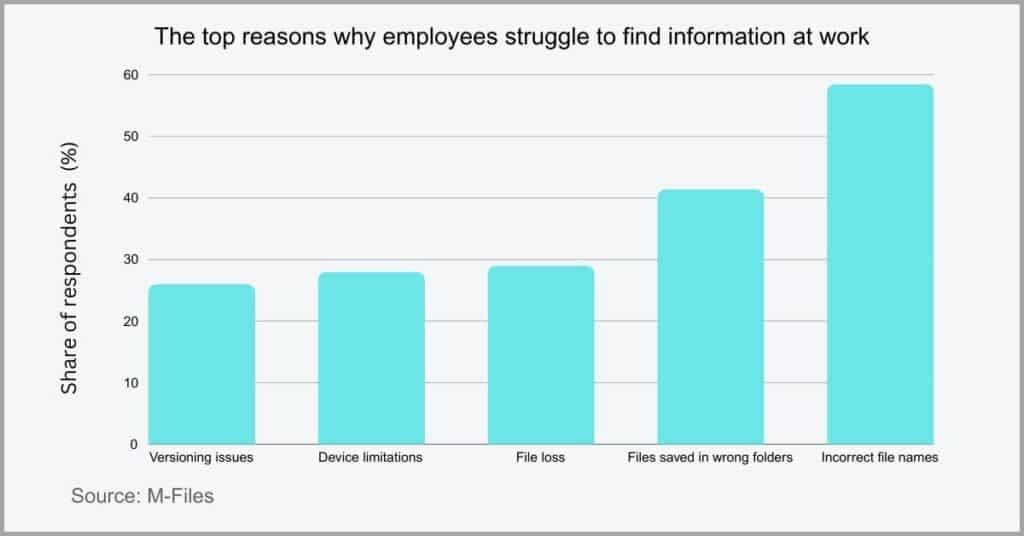
So what are the benefits of AI-powered document classification?
With intelligent document sorting, you can set rules that route files to specific directories depending on the sensitivity of its content and other factors.
This makes it easier to keep your files organized and secure by ensuring they’re always saved in the right locations. Furthermore, it takes away the burden of having to manually scrutinize and group files, which makes you more efficient and productive.
Flydocs, a document management platform for the aviation industry, handled over 572 millions of files which required proper classification for compliance purposes.
With AI-driven document classification, they automated 98% of processes with regard to manual document grouping and sorting. This boosted productivity and enabled them to focus more on more complex tasks in their industry.
2. Cloud-based collaboration tools
Does your SaaS firm have a remote work model?
Remote work is fast on the rise today, fueled by the need to tap into global talents, minimize operational costs and appeal to employees who prefer this way of working because of the convenience it affords.
However, remote work has necessitated the need to access data and collaborate remotely, which is greatly hindered by disparate and siloed legacy systems.
A survey by Statista revealed that 79% of workers used digital collaboration platforms in 2021 to improve teamwork. This represents a remarkable increase of more than 44% compared to the previous two years.
In other words, many SaaS firms are turning to document management trends like cloud-based technologies to meet the collaboration demands of remote work.
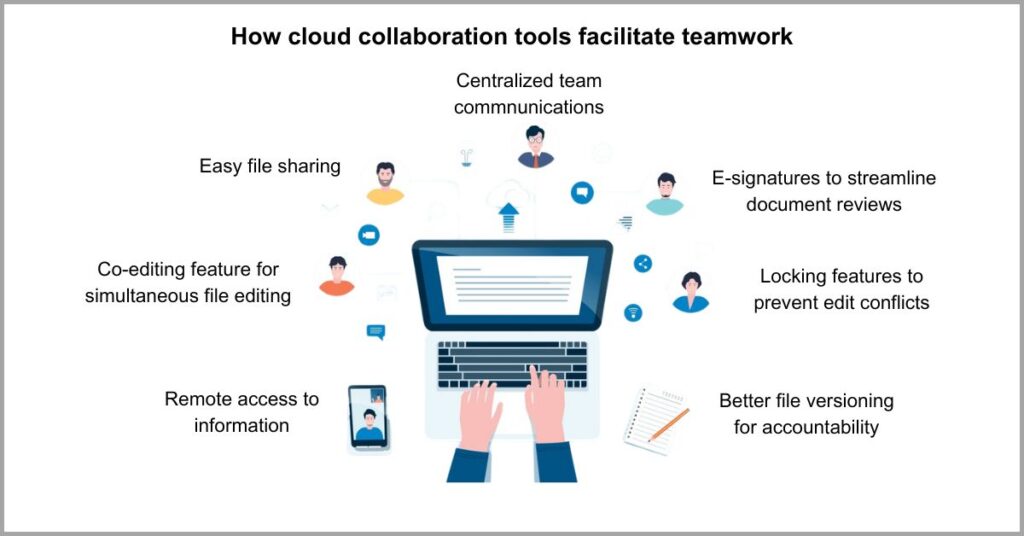
One way these tools improve collaboration is through co-editing and file versioning.
With proven cloud-based document management software, for instance, you can simultaneously edit a document in real time with multiple collaborators. All changes create unique file versions so you don’t lose your work, and this enhances teamwork.
Cloud tools also boost collaboration by helping you centralize project management, enhance team communication, and access and share information remotely.
A few examples of popular cloud-based solutions I recommend for enhancing teamwork for your SaaS firm include FileCenter, Trello, and Asana.
With Trello, you can assign and oversee tasks more effectively. Asana, on the other hand, centralizes and improves communication while our software, FileCenter, offers remote file access and document co-editing to boost collaboration on document work.
3. Advanced OCR technology
OCR is only getting better and more reliable.
This is driven by the advancement of technology, with machine learning algorithms helping to improve the accuracy of OCR in terms of recognizing text and characters more accurately and processing these tasks faster.
Without modern-day OCR technologies, your SaaS firm would waste a lot of time on error-riddled manual data entry while you also risk siloing information.
In fact, over 76% of office workers spend at least three days daily on manually data entry tasks, according to a Zapier survey. This shows just how big a time sink this is, with these productivity losses translating to significant revenue dips.
With intelligent OCR technology, you can automate the extraction of data from paperwork to minimize iterative tasks, reduce errors and increase your efficiency.
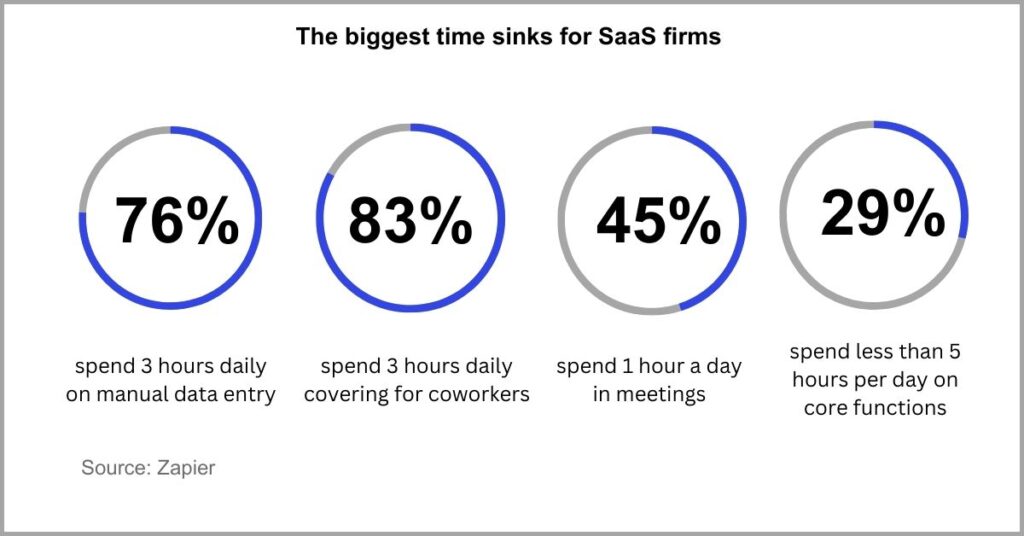
But what else does OCR technology offer?
It’s also a big help in shattering data silos created by legacy scanning solutions.
For example, the best PDF to OCR software solutions recognize text with scanned images, helping to digitize a physical document down to the last full stop. This means that there’s now actual text for you to search through when looking up files.
As a SaaS firm, you can use OCR tools to digitize non-disclosure agreements, service level agreements with vendors and employee records to make them searchable .
This technology is also great for automating the extraction of data from forms and surveys to help improve customer service. What’s more, you can leverage it to improve invoice scanning and therefore streamline financial reporting.
4. Blockchain for document verification
Want to improve document security for your SaaS?
Then blockchain may be the way to go. This technology creates immutable copies of documents, and any changes result in the creation of a new version entirely with a different digital identity, therefore ensuring that original files are essentially tamper-proof.
Today, document forgery is a huge problem in light of the growing complexity of modern threats, and it can lead to legal complications and financial loss.
A study by Shufti Pro revealed a 30% year-on-year increase in document fraud. This calls for innovative solutions in document management to ensure the situation doesn’t spiral out of control.
Blockchain is certainly one of the top document management trends in this regard, because it can automate document verification to reduce the risk of tampering.
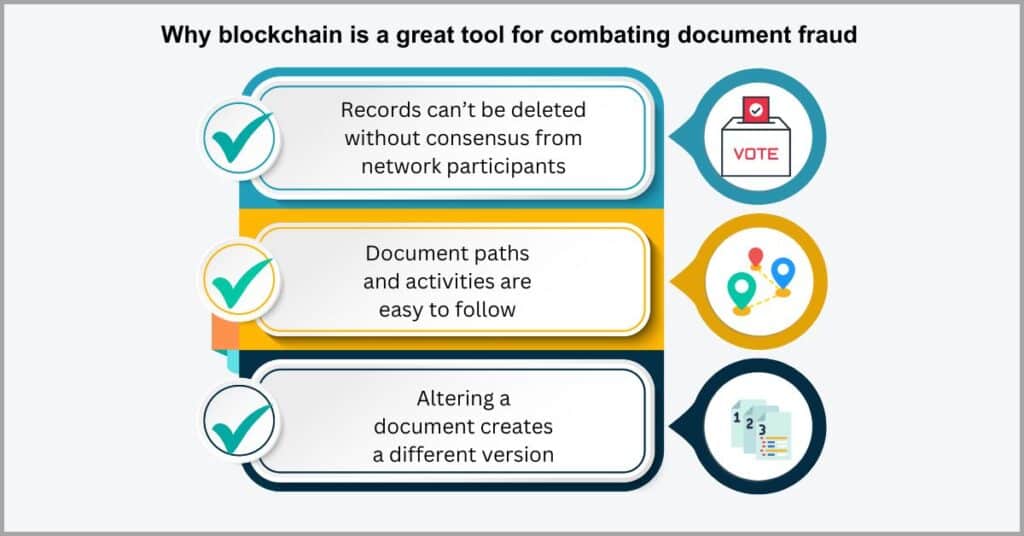
One way blockchain enables verification is by improving document traceability.
You can trace it back to its source, which improves transparency by revealing the document’s pathways.
With blockchain, it’s also possible to add unique digital identifiers to documents.
This makes it easy to validate a file by a digital identifier provided by the original owner or issuing party, which can help authenticate KYC documents for your SaaS.
Overall, this means you can improve regulatory compliance with blockchain-driven document management. It can help protect the privacy and integrity of data and prevent misuse, which is a key stipulation in many regulatory guidelines.
By giving everyone easy and secure access to documents, blockchain may also be an excellent alternative to vulnerable third-party sharing solutions like email.
5. Leveraging SEO for DMS SaaS growth
SEO is especially important for your SaaS DMS business.
That’s because the online space is your primary source of leads, and you need to be able to reach them in a space crowded with several other competitors.
If your SaaS site isn’t SEO-friendly, it’s easy to get outranked by competitors, and this leads to low website traffic and fewer leads and sales for your business.
The situation is quite dire, with 34% of SaaS businesses getting between zero to 1,000 visitors per month, according to a Swipe Files survey. As a result, many of them are barely breaking even.
Therefore, SEO is an essential driver for SaaS marketing success because it can help you stand out in a crowded market, and generate more software sales.
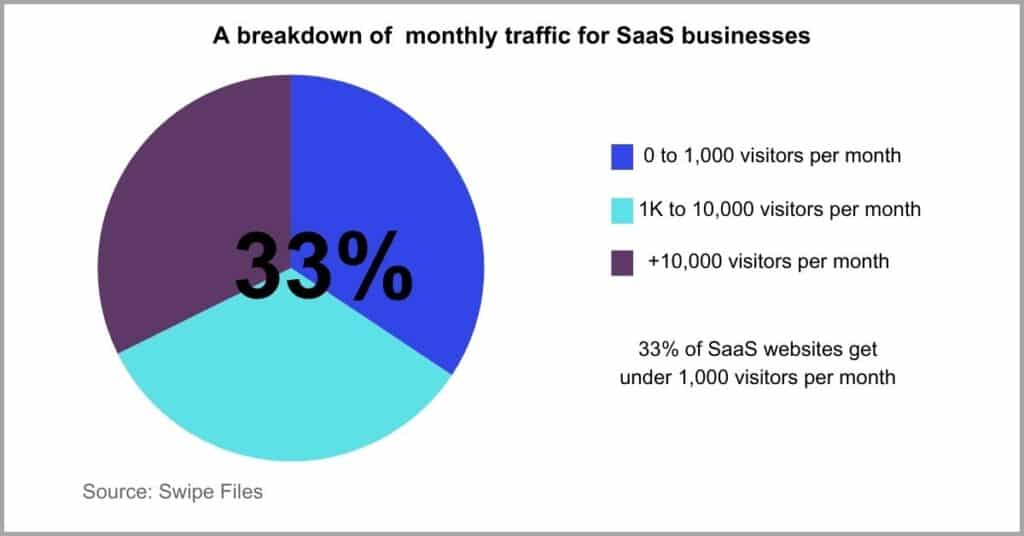
But how can SEO boost visibility for your SaaS firm?
It’s crucial to work with a great SaaS SEO agency to avoid getting low-quality traffic. With SaaS traffic typically about quality over quantity, your agency can help reel in the right kind of traffic that converts into paying and loyal subscribers.
Through meticulous keyword research, content marketing and technical optimization, SEO improves awareness, rankings and the quality of your leads.
If your target market is small businesses, I recommend considering agencies who are experienced in marketing small business document management solutions and can back it up with proof of results.
In addition to a proven track record, it’s important to understand their full range of services to determine if this is a perfect fit for your needs and objectives.
6. Mobile-first document management
Are your document processes mobile-friendly?
A user may run into problems with their subscription, and you may need to retrieve information while you’re out of the office. If this isn’t possible, you’ll need to hand them over to someone else or make them wait, both of which are frustrating for customers.
In addition, not being able to access information remotely and on mobile can hold up your workflow, and cause huge productivity drains for employees.
A Deloitte survey revealed that 66% of employees said mobile-friendly technologies made it easier and faster to access information. This helped to improve productivity and deliver better customer experiences.
Moreover, the respondents added that they made collaboration easier, showing the many benefits of embracing document management trends like mobile-first platforms.
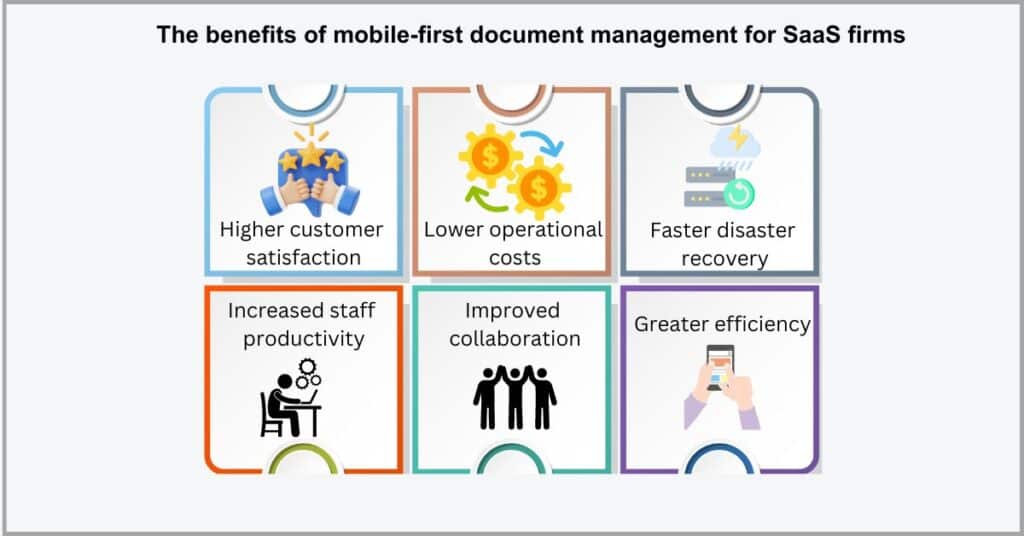
One key feature of a mobile friendly document management solution is excellent responsiveness across devices.
While it may not deliver the same advanced functions as its desktop application, it should at the very least let you access, edit and even share information more easily so you can work on the go.
It should also let you scan documents on iPhone or Android, to enable document digitization without dedicated equipment like a scanner. Moreover, a great tool should also cross-platform compatibility to accommodate different end-user devices.
With mobile-first document management, remote work productivity greatly improves.
You can gain instant access to business information without the back-and-forth associated with traditional file sharing, thereby decreasing information retrieval times to increase direct work times for your SaaS firm.
7. Automated metadata tagging
Metadata is descriptive data about a document.
It outlines vital and typically unique characteristics that often differentiate one file from another, encompassing details such as file names, categories, file types and more.
Without metadata to guide you, it’d take a painful amount of time to retrieve the files you need and you may even fail to find documents entirely.
In fact, 81% of workers have a hard time locating files when necessary, going by a survey by Elastic. Upon closer inspection, I realized these challenges boil down to incorrect document naming and grouping, which are essentially metadata issues.
Such cases would certainly be much fewer with automated metadata tagging, which helps to make documents more searchable, thereby allowing you to quickly fulfill customer or management requests for various documents.
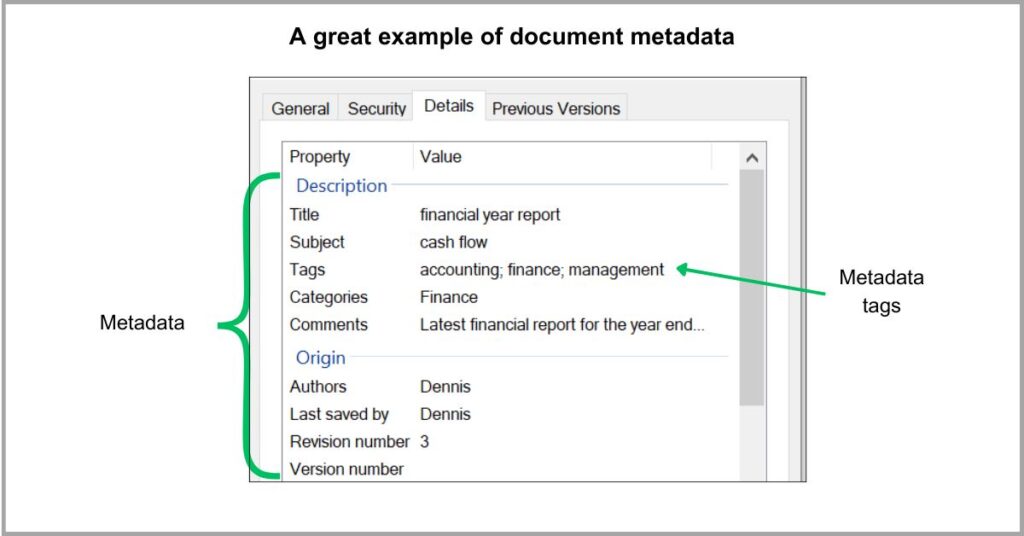
So how does metadata improve document searchability?
By assigning descriptive elements like titles, names, and summary descriptions, to documents, it becomes very easy to look up and find files depending on a large number of unique criteria without having to open each document.
When you get metadata document management right, data organization also improves. That’s because you can automatically group related information flowing in from different sources into appropriate categories such as finance, customer information, and so on.
With the ability to find related documents in one place, this means you’ll spend less time searching for information, therefore making you even more efficient and productive.
Automated metadata tagging also saves you time by completely taking over and eliminating manual document tagging tasks for your SaaS business.
8. Version control and audit trails
Do you often work on the same files with teammates?
In a collaborative environment, multiple users can make changes to a document, and it can be difficult to keep track of revisions and access the latest document versions.
With poor audit trails & a lack of strict version control, you can make conflicting edits and collaboration can quickly turn into a liability for your SaaS firm.
It is the case today that 83% of workers experience document versioning challenges that end up wasting valuable time, according to a study by Perforce. This is because they may need to rework files or manually chase after recent versions.
In addition to time wastage, this can also give rise to compliance headaches due to challenges in tracking document revisions and histories.
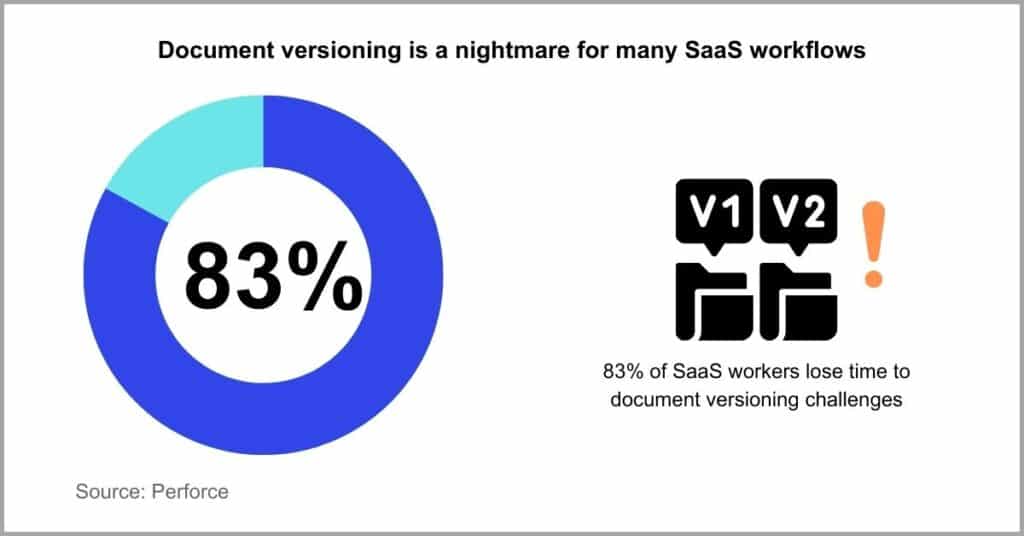
At the very least, a modern version control system should provide comprehensive user activity tracking and automated audit trails, complete with date and time stamps. This helps to improve accountability in your collaborative workflow.
It should also offer sequential file version numbering to help you distinguish one version from the other and improve SaaS business document management at large.
Additionally, I recommend getting a tool with version rollback features, which allows you to revert to a previous document version when you need to.
A great version control system also streamlines compliance so you can avoid penalties.
This is because it enables your SaaS firm to preserve document changes, ensure that your change management procedures were properly followed, and streamline information retrieval about document versions during compliance audits.
9. NLP for document analysis
What is Natural Language Processing or NLP?
It is a subset of artificial intelligence, which essentially entails AI models being able to read, decipher and interpret natural language almost in the same way we do.
While you may struggle to understand your data when it gets too complex, NLP models can help break down information to relevant insights quickly.
Unfortunately, nearly 4 in 5 SaaS businesses are struggling to get any value from their data, according to a survey by Cognopia. Two leading reasons for this are big data getting bigger than ever and a shortage of expertise.
NLP is among the document management trends that changes this situation, helping your SaaS firm to understand its data without special skills to accelerate data maturity.
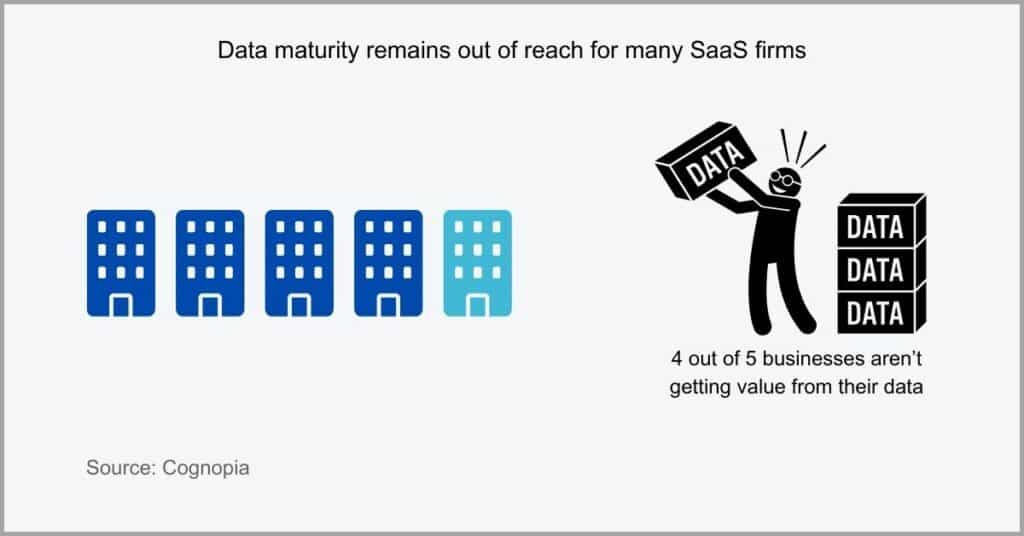
So what are the applications of NLP in document management?
I’ve noticed several of the best document management platforms leveraging chatbots for text analytics. You can query these virtual assistants, and they’ll rummage through lengthy documents with thousands of pages to dig up just the insights you need.
Furthermore, this technology is also helping to ensure the proper classification of documents based on content for compliance purposes, while enabling you to work with multilingual documents thanks to NLP-powered translations.
In addition to making you more efficient and productive, NLP-driven models generally make it easy to spot patterns from data using natural language rather than coding.
This helps improve business intelligence for your SaaS business, allowing you to understand customers and your market better to unearth profitable opportunities.
10. Integration with CRM Software
Strong relationships encourage subscription renewals.
This is why it’s important to be able to integrate document management solutions with your customer relationship management systems, to get a unified view of customers and strengthen ties with your subscriber base.
If the integration between your CRM and document management system is poor, this can alienate customer data and decrease customer service quality.
In fact, an Emplifi study revealed that 80% of customers are likely to leave a SaaS company they were previously loyal to after a poor customer service experience. So the stakes couldn’t be higher to get things right.
This is where document management system and CRM integrations come in, enabling you to decrease time spent chasing after information so you can focus on customers.
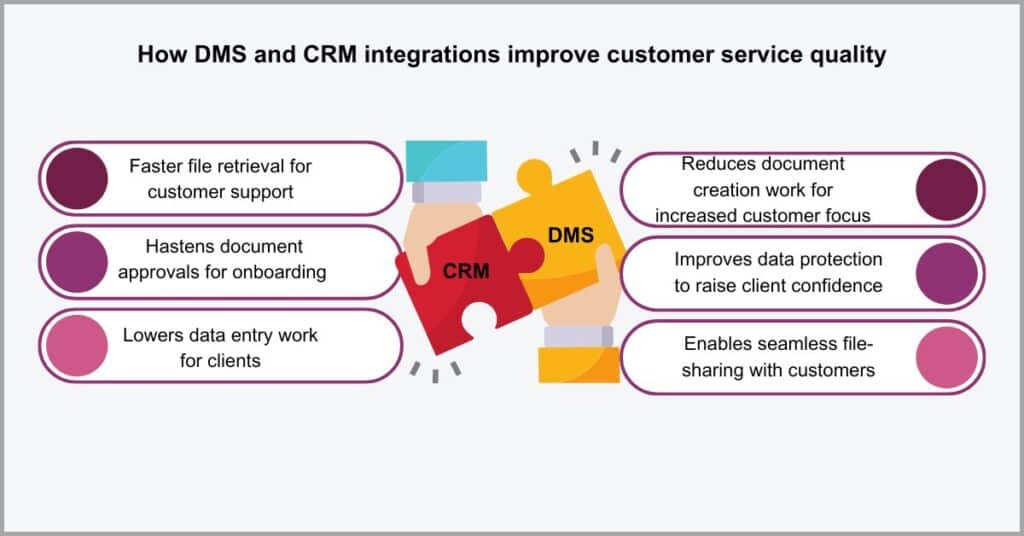
How can this integration improve customer and sales experiences?
Well, the right paperless document management software can help you digitize files and make it easy to extract key data into your CRM. In addition, they also provide document templates and forms that can help streamline customer onboarding.
For your sales team, this CRM and DMS integration can also mean greater efficiency and freedom from interactive document-related tasks so they can focus on sales. This is made possible by automated document routing and approval workflows.
Technology consulting firm OpMentors previously relied on legacy document management solutions that were extremely labor and time-intensive.
Ultimately, they decreased document creation time by 90% and sales cycles by 27%. This was down to an excellent document management system and Salesforce integration, which streamlined document work to improve customer support.
Conclusion
Document work is an inevitable part of SaaS workflows.
However, when ill managed, inefficiencies and labor needs can grow astronomically.
Poor document management ultimately inflates operational costs, and you may need to redirect huge amounts of your MRR just to keep the lights on.
Unfortunately, over 79% of SaaS companies are operating at the break-even point, according to a SaaS Capital study. Cost-efficient document management can certainly help tip the scales in the right direction.
By embracing document management trends like AI-powered document classification, cloud-based collaboration and advanced OCT technologies, you’ll reduce many document-related expenses for your SaaS and grow your bottom line.
As technology continues to push the envelope, we can expect even more game-changing innovations to increase document management efficiency in SaaS.
Until then, I recommend putting these trends to work quickly to help raise employee productivity, improve customer experiences, and increase profitability for your SaaS.


